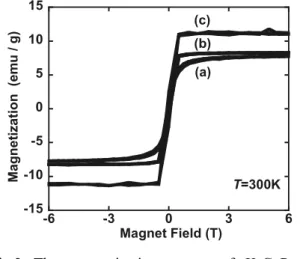埼玉大学 工学部紀要 第 44 号
(原稿受付日:平成 23 年 6 月 29 日)
7
論文
カリウムを添加したコバルトフタロシアニンの高温分子磁性
High Temperature Molecular Magnetism in Potassium Doped Cobalt Phthalocyanines
岩崎惇*
,
本多善太郎*,
福田武司*,
鎌田憲彦*Makoto IWASAKI, Zentaro HONDA, Takeshi FUKUDA and Norihiko KAMATA
The magnetic properties of potassium doped cobalt phthalocyanines were investigated. The temperature dependence of the magnetization indicates ferromagnetic and superparamagnetic behavior and the magnetization curves indicate the coexistence of a ferromagnetic and a paramagnetic component. Some particles of polycrystalline samples were attracted to a strong magnet at room temperature. The saturation of the magnetization is almost reached with a value of 11.1 emu/g at 300K. The origin of the high temperature ferromagnetism in potassium doped cobalt phthalocyanines is discussed.
Keywords: Molecular magnet, Cobalt Phthalocyanine, High temperature ferromagnetism
1.
序論金属フタロシアニンは熱的、光学的に非常に安定な 平面状の有機金属錯体であり、有機顔料や有機半導体 として様々な分野での応用が期待されている1) 2)。我々 は特に、金属フタロシアニンが磁性元素を含むことに 注目し、有機磁性体としての可能性を模索してきた。
金属フタロシアニンのように、有機分子が構成単位と なり磁性が発現する有機磁性体は、従来の無機磁性体 と比べ、元素戦略性に優れ、軽量軟質、色彩等の機能 性を併せ持つ3) 4)。しかし、有機磁性体は磁性が保持さ れる温度限界(キュリー温度)が低い等の問題点があ
り、実用が困難とされている5) 6) 7)。ところが近年、ア ルカリ金属をドープした一部のフタロシアニンで、室 温強磁性の発現が報告された 8) 9) 10)。有機磁性体にお けるキュリー温度の向上は、実用磁石の観点から非常 に興味深く、注目される。本研究では、有機磁性体の 一種であり、室温では強磁性を示さないコバルトフタ ロシアニン(CoPc)に対してカリウム金属(K)のド ープを試み、ドープ前後における試料の磁気特性の変 化について検討を行った為、その結果を報告する。
2.
実験方法市販の
CoPc
粉末を、450℃で真空下(10
-1Torr)
、電 気炉を用いて昇華精製した。昇華したCoPc
粉末と金 属カリウムをシリカガラス管に入れ、真空下(10-5Torr)
で封入した。封入したカリウムの量は、モル比で
CoPc:K
= 1:10とした。全ての操作は、窒素ガス雰囲気のグローブボックス内で行った。原料を真空封 入したシリカガラス管を、24 時間、350℃-450℃の 温度で電気炉を用いて加熱した。得られた粉末試料の
* 埼玉大学大学院 理工学研究科 物理機能系専攻
機能材料工学コースCourse in Functional Materials Science, Program in
Physics and Functional Materials Science, Graduate
School of Science and Engineering, Saitama University,
255 Shimo-Okubo, Sakura-ku, Saitama-shi, Saitama,
338-8570, Japan
カリウムを添加したコバルトフタロシアニンの高温分子磁性
8
-10
-5 0 5 10
-1 -0.5 0 0.5 1
Magnetization(emu / g)
Magnet Field (T) (a) (b)
-15 -10 -5 0 5 10 15
-6 -3 0 3 6
T=300K
(b)
(c)
(a)
Magnet Field (T)
Magnetization(emu / g)
磁気測定には
SQUID
磁束計(Quantum Design社製MPMS-XL)を用いた。試料の結晶構造の同定には粉
末X
線回折計(Rigaku社製RINT-UltimaⅢ)を用い
た。3. 結果と考察 3.1 K-CoPcの磁化曲線
Figure 1
に、カリウムドープ前のCoPc (a)と、 400℃
で
CoPc
にカリウムドープ処理を行ったK-CoPc (b)の
磁化曲線を示す。カリウムドープ前のCoPc
の磁化は、磁場の印加に伴い直線的に増加した。一方、400℃で カリウムをドープした
K-CoPc
の磁化曲線は、小さな磁場の印加によって磁化が飽和し、さらに、磁気履歴 の存在が認められた。したがって、
CoPc
が常磁性体で あるのに対し、K-CoPc は室温で強磁性が発現してい ると考えられる。また、K-CoPc
の飽和磁化は8 emu/g、
保持力は
30 Oe
程度と、通常の無機強磁性体に比べて比較的小さい値を示した。
さらに、CoPc とカリウムの反応温度を
350℃ (a)、
400℃ (b)、 450℃ (c)と変化させた時の磁化曲線を Fig.
2
に示す。CoPc
とカリウムを400℃で加熱処理した試
料と同様に350℃、 450℃で加熱処理した K-CoPc
にお いても室温で強磁性が発現した。しかし、K-CoPc の 飽和磁化Ms
は、CoPc
とカリウムの反応温度により異 なり、反応温度が高くなるにつれ、増加することが確 認された。450℃で合成した K-CoPc
は最も飽和磁化が 大きく、Ms=11.1 emu/gとなった。3.2 K-CoPcの磁化の温度依存性
Figure 3
は、昇華精製したCoPc (a)と、CoPc
とカ リウムの反応温度をそれぞれ350℃ (b)、400℃ (c)、
450℃ (d)と変化させた試料の磁化の温度依存性を示
している。これらの磁化の温度依存性は、無磁場冷却(ZFC)の条件下で測定した値である。CoPc
の曲線 (a)と比べると、
CoPc
とカリウムを加熱処理した試料 (b)、(c)、(d)の曲線では温度 2K
から300K
で大幅な磁化の 増加が確認されたが、その温度依存性は加熱処理温度 により定性的に異なることが認められた。350℃、400℃で合成した K-CoPc
の曲線 (b)、(c)は、温度の増
加に伴い、磁化が減尐した。特に、400℃で合成したK-CoPc
はFig. 4
に示すように、ZFCの条件下におい て、磁化が極大を持ち、温度50K
以下の低温で磁気履 歴が見られた。その振る舞いは超常磁性体の磁化の温 度依存性に類似している11) 12)。したがって、加熱温度350℃及び 400℃の K-CoPc
結晶内にナノサイズの強磁性クラスターが形成されている可能性が考えられる。
さらに、反応温度
450℃で合成した K-CoPc
の曲線 (d) では、温度の上昇に伴う一様な磁化の増加が確認されFig.1 The magnetization curves of CoPc at T=2K (a)
and K-CoPc at T=300K (b).
Fig.2 The magnetization curves of K-CoPc at
T=300K. The reaction temperatures are
350 ℃ (a), 400 ℃ (b) and 450 ℃ (c),
respectively.
埼玉大学 工学部紀要 第 44 号
9 -0.01
0 0.01 0.02 0.03 0.04
0 100 200 300
Magnetization(emu / g)
Temperature (K) H=0.01 T, ZFC
(a) (b) (c) (d)
0 0.01 0.02 0.03 0.04 0.05
0 100 200 300
Magnetization(emu / g)
Temperature (K) H=0.01 T (a)
(b)
ており、室温以上のキュリー温度を有する強磁性の発 現が観測された。以上の結果から、
CoPc
とカリウムの 反応温度が高くなるにつれ、K-CoPc 結晶内の強磁性 クラスターのサイズが徐々に大きくなり、450℃で合成した
K-CoPc
では、バルク強磁性体による室温強磁性が発現したと考えられる。我々が
350℃-450℃で合
成した
K-CoPc
試料のX
線回折の結果からは、室温以上にキュリー温度を有する金属コバルトの析出は認め られなかった。したがって、K-CoPc 試料の室温強磁 性の原因は金属コバルトによるものではないと考えら れる。さらに、X線回折パターンに
CoPc
及びそれ以 外の同定されないピークも観測されていることから、CoPc
及びその熱分解生成物等の有機物が室温強磁性 の原因になっている可能性が高い。4. 結論
CoPc
とカリウムの加熱処理により作製したK-CoPc
において、室温で強磁性を観測した。さらに、CoPc とカリウムの反応温度が高くなるにつれ、その飽和磁 化が大きくなることを明らかにした。一方、K-CoPc の磁化の温度依存性は、カリウムドープ時の反応温度 により定性的に異なった。特に400
℃で合成したK-CoPc
は、超常磁性による磁気履歴現象が50K
以下の温度域で確認されており、K-CoPc 結晶内にナノサ イズの強磁性クラスターが形成された可能性が考えら れる。X 線回折の結果から、これらの強磁性の原因は 金属コバルトの析出ではなく、
CoPc
等の分子磁性の可 能性が高いと考えられる。本研究結果より、金属フタ ロシアニンを基にした有機磁性材料としての応用展開 の足がかりが得られたと考えられる。参考文献
1) Ph.Turek, M. Moussavi, P. Petit and J.-J. Andre, Synthetic Metals, Vol.29, pp65-70, 1989.
2) J.-J. Andre, M. Brinkmann, Synthetic Metals, Vol.90, pp211-216, 1997.
3) Y. Taguchi, T. Miyake, S. Margadonna, K. Kato, K. Prassides, Y. Iwasa, J.Am.Chem.Soc., Vol.128 (10), pp3313-3323, 2006.
4) Y. Taguchi, T. Miyake, S. Margadonna, K. Kato, K. Prassides, Y. Iwasa, Journal of Magnetism and Magnetic Materials, Vol.310, pp1229-1230, 2007.
5) Hirokazu Miyoshi, Hiroaki Ohya-Nishiguchi, and Yasuo Deguchi, Bulletin of the Chemical Society of Japan,Vol.46, pp2724-2728,1973.
6) A.R.Harutyunyan, Chemical Physics Letters, Vol.246, pp615-618, 1995.
7) Samaresh Mitra, Anthony K. Gregson, William E. Hatfield, Robert R. Weller, Inorganic Chemistry, Vol.22 (12), pp1729-1732, 1983.
Fig.3 The temperature dependence of the magnetization of CoPc (a) and K-CoPc.
The reaction temperatures are 350℃ (b), 400℃ (c) and 450℃ (d), respectively.
Fig.4 The temperature dependence of the
magnetization of K-CoPc at ZFC (a) and at
FC (b). The reaction temperature is 400℃.
カリウムを添加したコバルトフタロシアニンの高温分子磁性
10
